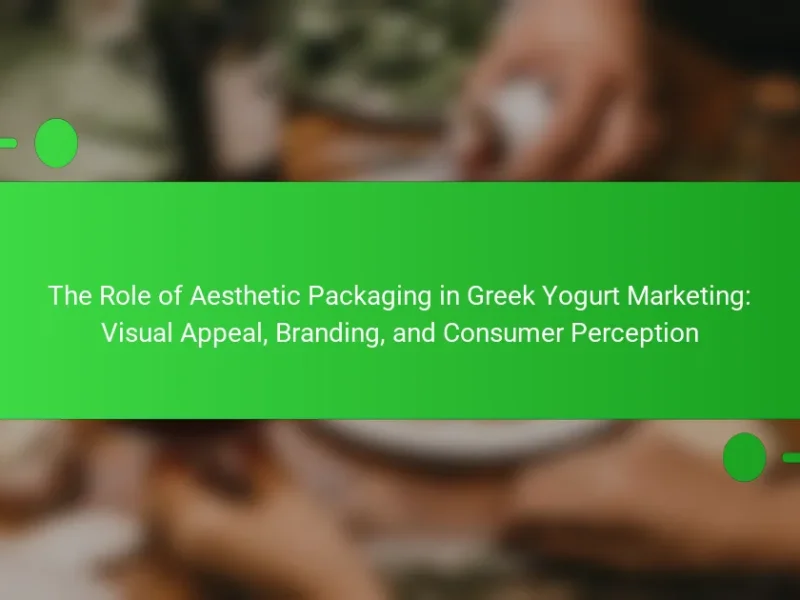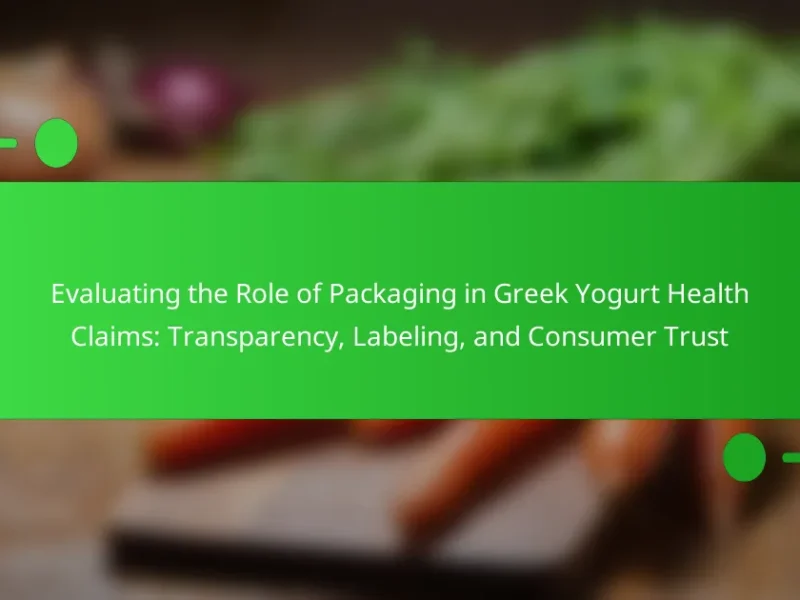Innovative packaging solutions for Greek yogurt focus on enhancing sustainability, design, and consumer appeal. Key advancements include the use of eco-friendly materials like biodegradable plastics and recyclable cartons, which aim to reduce environmental impact. Additionally, portion-controlled containers promote convenience and waste reduction, while resealable designs improve product longevity and usability. These innovations reflect a growing consumer demand for sustainable and convenient food packaging options.

What are Innovative Packaging Solutions for Greek Yogurt?
Innovative packaging solutions for Greek yogurt include eco-friendly materials, portion-controlled containers, and resealable designs. Eco-friendly materials, such as biodegradable plastics and recyclable cartons, reduce environmental impact. Portion-controlled containers cater to consumer convenience and minimize waste. Resealable designs enhance product longevity and usability. These packaging innovations align with consumer demand for sustainability and convenience in food products.
How do these packaging solutions enhance sustainability?
Innovative packaging solutions enhance sustainability by utilizing eco-friendly materials. These materials reduce environmental impact during production and disposal. Many solutions incorporate biodegradable or recyclable components. This minimizes waste in landfills and promotes a circular economy. Additionally, some packaging designs optimize space and reduce transportation emissions. Efficient designs lead to lower carbon footprints during distribution. Furthermore, these solutions often use less material without compromising quality. This contributes to resource conservation and lowers overall energy consumption. Together, these factors demonstrate a commitment to sustainable practices in the packaging industry.
What materials are commonly used in sustainable Greek yogurt packaging?
Sustainable Greek yogurt packaging commonly uses materials such as recycled paper, biodegradable plastics, and glass. Recycled paper is often utilized for outer packaging due to its eco-friendliness. Biodegradable plastics are designed to break down more easily than traditional plastics, reducing environmental impact. Glass packaging is favored for its recyclability and ability to preserve product quality. These materials align with sustainability goals by minimizing waste and promoting recycling. Brands are increasingly adopting these materials to enhance their environmental responsibility.
How do these materials impact the environment?
Innovative packaging materials for Greek yogurt can significantly impact the environment. Many materials, such as plastics, contribute to pollution and waste. Plastics often take hundreds of years to decompose. This leads to increased landfill use and environmental degradation. Biodegradable alternatives, while better, may still require specific conditions to break down effectively. Additionally, the production of these materials can consume energy and natural resources. For example, the extraction of raw materials for plastic manufacturing can lead to habitat destruction. Therefore, the choice of packaging materials directly influences environmental sustainability.
What design elements are crucial in packaging Greek yogurt?
Crucial design elements in packaging Greek yogurt include functionality, aesthetics, and sustainability. Functionality ensures the packaging preserves freshness and prevents spills. Aesthetics attract consumers through appealing visuals and branding. Sustainability is increasingly important, with eco-friendly materials gaining consumer preference. Research indicates that 74% of consumers are willing to pay more for sustainable packaging (Nielsen, 2018). Clear labeling of nutritional information and ingredient transparency also enhances consumer trust. Additionally, portion control designs cater to convenience and health-conscious consumers. These elements collectively influence purchasing decisions and brand loyalty.
How does packaging design influence consumer perception?
Packaging design significantly influences consumer perception by affecting brand recognition and product appeal. Visually appealing packaging can attract consumers’ attention and create a positive first impression. Research indicates that 72% of consumers judge a product by its packaging. Effective design communicates quality and value, enhancing perceived product benefits. Additionally, sustainable packaging can improve brand image, as 66% of consumers prefer brands that demonstrate environmental responsibility. Thus, thoughtful packaging design plays a crucial role in shaping consumer attitudes and purchasing decisions.
What role does branding play in packaging design for Greek yogurt?
Branding plays a crucial role in packaging design for Greek yogurt. It helps to establish a unique identity for the product. Effective branding differentiates the yogurt from competitors. This differentiation can influence consumer purchasing decisions. Packaging elements like color, typography, and imagery communicate brand values. For example, a premium brand may use elegant designs and sophisticated colors. Research shows that 64% of consumers are more likely to buy a product with a distinctive package design. Additionally, branding enhances brand recognition and loyalty among consumers. Consistent branding across packaging fosters trust and familiarity with the product.
Why is consumer appeal important in Greek yogurt packaging?
Consumer appeal is crucial in Greek yogurt packaging because it directly influences purchasing decisions. Attractive packaging can enhance brand recognition and loyalty. Research indicates that visually appealing designs increase consumer interest by up to 70%. Effective packaging communicates product benefits clearly, such as health attributes and sustainability. Consumers often associate quality with well-designed packaging. In a competitive market, standout packaging can differentiate a brand from its competitors. Additionally, eco-friendly packaging resonates with environmentally conscious consumers. This alignment with consumer values can lead to increased sales and market share.
What factors contribute to consumer preferences in yogurt packaging?
Consumer preferences in yogurt packaging are influenced by several factors. Key factors include convenience, sustainability, and aesthetics. Convenience relates to the ease of use and portability of packaging. Many consumers prefer single-serve sizes for on-the-go consumption. Sustainability is increasingly important, with consumers favoring eco-friendly materials. Research shows that 66% of consumers are willing to pay more for sustainable packaging. Aesthetics play a role in attracting consumers through appealing designs and colors. Packaging that clearly communicates health benefits also influences choices. Additionally, brand reputation can impact consumer trust in packaging. Overall, these factors shape consumer decisions in yogurt packaging.
How can packaging design affect purchase decisions?
Packaging design significantly influences purchase decisions by attracting consumer attention and conveying brand identity. Eye-catching designs can differentiate products on crowded shelves. Research shows that 70% of purchasing decisions are made in-store, highlighting the importance of packaging. Effective packaging communicates product benefits and quality, establishing trust with consumers. For instance, eco-friendly materials appeal to environmentally conscious buyers. Studies indicate that 60% of consumers prefer sustainable packaging options. Overall, packaging design plays a crucial role in shaping consumer perceptions and driving sales.
How do innovative packaging solutions address market trends?
Innovative packaging solutions address market trends by enhancing sustainability, improving consumer convenience, and increasing shelf appeal. These solutions often utilize eco-friendly materials that reduce environmental impact. For example, biodegradable and recyclable packaging is increasingly preferred by consumers. Additionally, smart packaging technologies, such as QR codes, provide interactive experiences. Research indicates that 70% of consumers are influenced by packaging design when making purchase decisions. Furthermore, innovative designs can differentiate products on crowded shelves, attracting more attention. Brands that adopt these strategies often see increased customer loyalty and higher sales.
What challenges do manufacturers face with Greek yogurt packaging?
Manufacturers face several challenges with Greek yogurt packaging. One significant challenge is ensuring product freshness and shelf life. Greek yogurt has a high protein content, which can affect its texture and taste over time. Packaging must effectively seal in freshness while preventing spoilage.
Another challenge is sustainability. Many consumers prefer eco-friendly packaging options. Manufacturers must balance sustainability with functionality and cost. Additionally, packaging must be designed for consumer convenience. This includes easy opening and resealing features.
Cost is also a critical factor. High-quality materials that maintain product integrity can be expensive. Manufacturers must find cost-effective solutions without compromising quality. Lastly, compliance with food safety regulations adds complexity to packaging design.
Overall, manufacturers must navigate these challenges to meet consumer demands and industry standards.
What best practices should be considered for effective packaging solutions?
Effective packaging solutions should prioritize sustainability, functionality, and consumer appeal. Sustainable materials reduce environmental impact, such as biodegradable or recyclable options. Functional design ensures ease of use and protection of the product. Clear labeling enhances consumer understanding and promotes informed choices. Additionally, appealing aesthetics attract consumer attention and foster brand loyalty. Research indicates that 74% of consumers are willing to pay more for sustainable packaging, highlighting its importance in purchasing decisions.
How can companies balance sustainability and aesthetics in packaging?
Companies can balance sustainability and aesthetics in packaging by using eco-friendly materials that also appeal visually. Sustainable materials, such as recycled paper or biodegradable plastics, can be designed with attractive graphics and colors. Incorporating minimalist designs enhances visual appeal while reducing material use. Additionally, companies can utilize innovative printing techniques that minimize environmental impact. Research shows that consumers prefer packaging that is both sustainable and visually appealing. According to a 2021 study by Nielsen, 73% of consumers are willing to pay more for sustainable packaging solutions. This indicates that sustainability and aesthetics can coexist effectively in packaging strategies.
What innovations are on the horizon for Greek yogurt packaging?
Innovations on the horizon for Greek yogurt packaging include biodegradable materials and smart packaging technologies. Biodegradable packaging reduces environmental impact and aligns with sustainability trends. Smart packaging can monitor freshness and provide real-time product information. These advancements aim to enhance consumer experience and reduce waste. Research indicates that 74% of consumers prefer eco-friendly packaging options. Brands are increasingly investing in these innovations to meet consumer demand and regulatory requirements.
Innovative packaging solutions for Greek yogurt focus on sustainability, design, and consumer appeal. Key aspects include the use of eco-friendly materials, such as biodegradable plastics and recyclable cartons, which reduce environmental impact. The article explores how portion-controlled and resealable designs enhance convenience and usability, while also addressing market trends and consumer preferences. Additionally, it highlights the challenges manufacturers face in balancing sustainability with functionality and cost, and outlines best practices for effective packaging solutions that resonate with environmentally conscious consumers.


